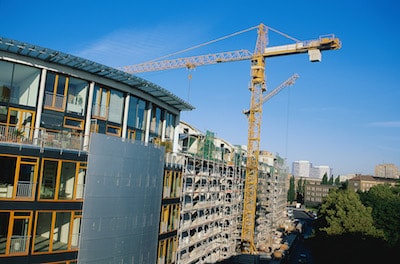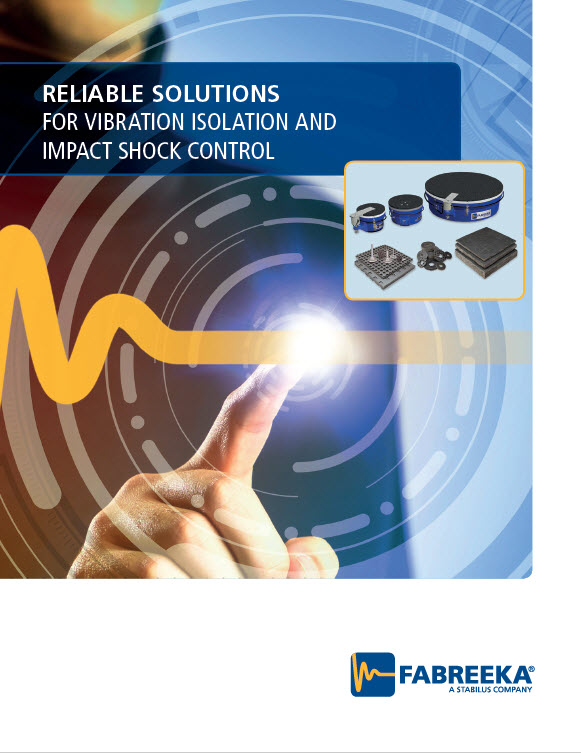Building and Construction
Architects, structural engineers and contractors around the world cooperate with Fabreeka International. They value the engineered material solutions as well as the company's expertise in reducing structure-borne noise, vibration and thermal bridging.
Fabreeka routinely provides a dynamic analysis of steel support structures, including a vibration survey and analysis, to determine current vibration levels and
finite element analysis (FEA) to predict resultant vibration for a recommended solution. Add an extensive product portfolio to these services and Fabreeka can offer one-stop vibration control and structure-borne noise solutions for a myriad of applications relative to building and construction. They include elevator isolation, stack vibration dampers to reduce vortex shedding on stacks or towers, fixed or expansion bearings for bridges and buildings, structural and non-structural thermal bridging solutions, and foundation isolation.
Bridges
Flexibility and movement are a necessity in bridge construction, whether a steel-bridge, a concrete highway overpass, or a bridge for a railroad. Without the ability to flex and move, the structural integrity of the bridge can be compromised, and eventually lead to failure. Fabreeka supplies bearing pads, both fixed and sliding, for bridges around the world.
Fixed bearing pads, such as
Fabreeka preformed fabric bearing pads and SA-47 random oriented fiber bearing pads are used on bridges to support uneven load and rotation on steel to steel or steel to concrete connections. These bearing pads, also known as bedding pads, provide uniform load distribution on highway and railroad bridges and reduce vibration by adding damping to steel structures.
Fabreeka’s expansion bearings, or
slide bearings, can be used on steel and precast concrete bridges. They offer a durable sliding surface with a low coefficient of friction to allow for thermal expansion and contraction in bridges to minimize structural stresses. Fabreeka type SBX expansion bearings include the company's own preformed fabric bearing pads to allow beam rotations created by loads. SBX expansion bearings also provide an even distribution of loads between members, and vibration is reduced by adding damping to steel structures.
Fabreeka designs and manufactures custom expansion bearings to
your specifications, including bearings with ultra-low coefficient of friction and bearings for high temperature applications.
Fabreeka’s Bridge Rail pads have simplified the installation of railings as our
SA-47 pad is supplied to the exact size and shape of the rail support contact area. This pad evenly distributes the loading and hold-down forces from the bolts by conforming to the irregularities of the surfaces in which it makes contact. Durable and dependable, Fabreeka bridge rail pads exhibit high compressive strength and a limited creep characteristic. These differentiating factors set them apart from the standard unreinforced neoprene pads, as well as making them a great alternative to epoxy and grout installations.
Fabreeka’s Lamp Post pads are an excellent and economical way to reduce shock and vibration induced by wind and traffic. Depending on the height of the pole and state specifications, pads made of either Fabreeka pad or SA-47 are supplied to the exact size, shape and bolt hole-pattern of the lamp post base. Lamp post pads help to evenly distribute loadings and adapt to any irregularities in the concrete mounting surfaces while providing damping to reduce post motion. Additionally, Fabreeka washers and bushings are utilized to completely isolate the lamp post from transmitted vibration.
Fabreeka’s Drain Trough material is manufactured into a flexible water drainage system for use on bridges and overpasses. Designed for installation under the expansion joint fingers, these flexible troughs channel water into rigid down spouts and avoid water dripping on vehicles passing under bridges.
Buildings
For decades, Fabreeka International has been successful in vibration isolation and reducing structure-borne noise in buildings. With the combined effort of our expert engineering staff and an extensive selection of materials, we provide solutions to the many needs and challenges facing construction in the modern world.
Our fixed bearing pads, whether Fabreeka or SA-47, support uneven load and rotation in steel to steel or steel to concrete connections, and provide even load distribution between members. Bearing pads reduce vibration on building floors, diminish structure-borne noise, and protect structural integrity by absorbing movement and deflection caused by movement.
Fabreeka provides structural expansion bearings, or slide bearings, for numerous building applications. These expansion bearings allow thermal expansion of beams and other members, and they permit beam rotations caused by loads and have a low coefficient of friction which minimizes structural stresses.
A building’s foundation can also require isolation from external vibrations such as traffic, trains, subway cars, or nearby construction. Fabreeka has several
foundation isolation products to isolate the building base from these disturbing influences.
Internal sources of structure-borne noise and vibration in buildings can come from mechanical rooms or elevator rail cars. Fabreeka reduces these noise and vibrations to provide a more serene environment for adjacent penthouses, offices, hotel rooms, or any other living spaces that could be adversely affected.
Today’s engineers and architects are well aware of the benefits of energy efficiency. One way to enhance energy performance is by adding a
Fabreeka-TIM structural thermal break, which is a load bearing thermal break that is used between flanged steel connections. This energy saving product maintains structural integrity while reducing energy transfer through the building envelope. This thermal bridging solution can be used on balconies and canopies, or other steel members protruding through the building envelope. For structural connections in compression, such as column bases, roof equipment, dunnage post support, and foundation connections,
Fabreeka-TIM RF can be used to reduce thermal energy transfer. Additionally, Fabreeka-TIM series products can bring you a step closer to achieving LEED certification.
Towers
Steel stacks and towers have relatively low inherent structural damping; therefore, excessive top-of-stack deflection can happen at critical wind speeds due to vortex shedding. To keep deflection within acceptable parameters, damping must be added to the “stack-foundation-soil” system. One way to achieve this is with stack foundation dampers. A ring of
Fabreeka preformed fabric pad is placed between the stack base plate and concrete foundation. Additionally, Fabreeka washers are installed between steel washers/plates under the anchor bolt nuts. Introducing damping to the structure minimizes amplification at resonance, therefore creating a more stable structure.





